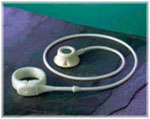Advantages
of Laparoscopic Adjustable Gastric Banding
- It
is minimal invasive laparoscopic placement
- It
is adjustable
- It
preserves the integrity of the stomach. No cutting or stapling
of the stomach is required and there is no bypassing of
portions of the stomach or intestines
- The
Lap-BandŽ can be removed laparoscopically at any time if
indicated
|

|
Indications
Morbid obesity is defined by the Metropolitan Live Insurance as
an excess weight of 45Kg or more as compared to the ideal body weight
(IBW). More than 25% of weight excess is linked with an increased
morbidity and mortality.
Selection
criteria according to the International Federation for the Surgery
of Obesity (IFSO)
BMI
>40 Body Mass Index = weight (Kg) ¸ Length2 (m2)
BMI
between 30 and 40 in the presence of an associated disease that
is treatable by weight loss (hypertension, type II diabetes, osteoarthritis,
sleep apnoea)
- Age
between 18 and 55
- Stable
obesity for more than 5 years
- Failure
of conservative treatment
- Absence
of endocrine pathology
- No
history of alcohol misuse
- Comprehension
and compliance by patient
- Acceptable
operative risk
- Women
must avoid becoming pregnant within two years of the operation.
- Patients
who elect to have this surgery must make the commitment to accept
significant changes in their eating habits for the rest of their
lives.
- A
long term follow up is required
Results
After
one year a loss of 60% of the excess weight can be expected. At
18 months of follow up 70% excess weight loss can be achieved. If
the patient is well motivated, the weight loss is usually permanent.
Complications
Like
any other surgical procedure the LAGB operation carries the risk
of complications. Apart from the more general complications such
as wound infection, thrombosis and respiratory tract infections,
there are specific complications associated with this procedure.
- Splenic
injuries have occurred during gastric restriction procedures.
Rarely a splenectomy is required.
- Migration
of the band and/or access port can occur, resulting in reduced
weight loss, weight gain or other complications, and possible
re-operation to remove or reposition the device.
- Band
erosions into the stomach are extremely rare but have been described.
- Pouch
slippage and pouch dilatation have been reported as both an early
and a late complication of this procedure.
- The
incidence of these problems is much less when an oesophago-gastric
banding is done. We adopted the latter technique in 1997.
- Infection
can occur at any time in the post operative period and this usually
necessitates band removal
- Nausea
and vomiting may occur, particularly in the first few days after
surgery and when the patient eats more than recommended
|


